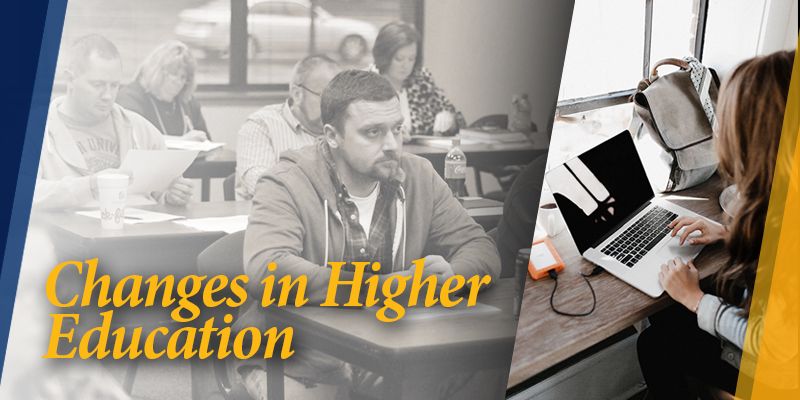Blog
Changes I've Seen in Higher Ed
By Amy Bennett | September 12, 2017

Higher education has changed significantly. Thirty years ago, universities only catered to traditional students—new high school graduates who went to college full-time; lived in a fraternity, sorority, or dorm on campus; and finished their degree in 4 years. Adult students were really a marginalized population and an afterthought by many in education administration. Adults who wanted to go back to school either quit their full-time jobs to attend college courses or they went to “night school” – semester-long evening classes which were sporadically offered.
All that changed in the 1990s when college administrators realized that they could expand their student base if they had programs that were really designed for this adult population that didn’t fit the norm. These students had different needs since they probably worked a full-time job, had a family, and also had competing responsibilities. Everything needed to change. The concept of embracing the non-traditional learner truly rocked the world of higher education.
Traditional educators all over the country thought the concept was radical, and I guess it was. Accelerated classes were offered in six- or eight week terms as opposed to the regular 16-week semester calendar. As a new admissions advisor, I remember thinking that the college I worked for was on the cutting edge when we started offering deferred billing to those students who had employer tuition assistance. We even mailed the student’s books to their home so the students didn’t have to go to the college’s bookstore. Admissions and academic advisors needed to be in the office later so they could work with students after they got off work.
At that point, some colleges, including the one I worked for, also offered “Independent Study” or correspondence classes. In our Independent Study classes, we mailed students the book, syllabus, and other course materials. The student completed the assignments and mailed them via the USPS back to the college. Seems archaic, right? But remember, online courses, as we know them today, did not exist.
Fast forward some 26 years to see the remarkable change in higher education:
- Adult student enrollment has increased dramatically. Depending on how you categorized students, some estimates say that 40 to 70% of all students are truly considered non-traditional as they work, go to school online, or attend part-time, and/or they support a family.
- The term “non-traditional” student has been replaced by the term “contemporary” student. This is a huge leap for all, as the term “non-traditional” tends to sound like the student is less than or not as good as a traditional student.
- Likewise, the term “traditional” student has been replaced by the term “classic” student.
- While we survived the explosion of huge for profit colleges sprouting up and then imploding, there is still more competition in the arena ranging from corporate training programs, free courses (i.e. MOOCs), and of course, online courses.
- Hybrid and true online courses are now mainstream. Even elite, Ivy League schools have gotten on the band wagon.
- Students demand more as they view themselves as customers so their expectations are elevated.
- Experiential learning (credit for what you know and have learned along the way) is offered at many colleges.
- Some universities have gone to competency-based or self-paced models instead of a typical course with a beginning and ending date.
- Courses are accessible. According to a study by Aslanian Market Research and the Learning House, 59% of online students report completing at least some coursework using a mobile device.
What do these changes mean for contemporary learners? Often, you have:
- More options. Whatever your learning style, there’s a program that’s right for you.
- More flexibility. Face to face courses, blended format courses, or totally online courses. There are even different types of online courses. Ones that you can listen to lectures whenever it’s convenient for you or ones that you log in and can see your instructor so you can actively participate and ask questions in real-time.
- A cost savings. Most programs for contemporary learners are at a reduced tuition rate.
- The ability to go at your own pace. You can choose to take a full-time load, part-time load, or even sit out a term or two. The choice is yours.
Most importantly, you get to accomplish your goal of earning a degree and not feel guilty that school isn’t your only priority. After all, many of us are just trying to reach a balance as we juggle life, work, and family responsibilities.
For more on juggling life, work, and family responsibilities, read "Mom Confessions: College Edition."
© 2021 Marian University
Notice of Nondiscrimination
Marian University does not discriminate on the basis of race, ethnicity, color, sex, gender, gender identity, sexual orientation, religion, creed, national origin, age or disabilities in the selection
of administrative personnel, faculty and staff, and students.
*Placement rates are gathered from data collected from graduates within six months of graduation.
Students may make a complaint to the Indiana Commission of Higher Education.
Marian University is sponsored by the Sisters of St. Francis, Oldenburg, Indiana.
Submit a Marketing Request
Website built with